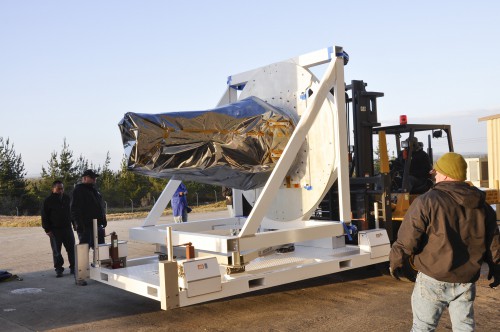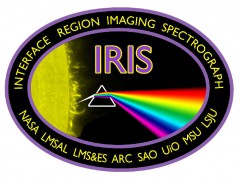
Six weeks before its scheduled launch, NASA’s Interface Region Imaging Spectrograph (IRIS) satellite was delivered to Vandenberg Air Force Base, Calif., last week for final preparations. The spacecraft is currently due to fly on 28 May aboard Orbital Sciences’ Pegasus air-launched booster, which itself will be transported to altitude under the wing of an L-1011 carrier aircraft from the West Coast launch site. Deployment of the Pegasus from the aircraft is targeted for 7:27 p.m. PDT, at an altitude of 39,000 feet and at a location over the Pacific Ocean, about 100 miles northwest of Vandenberg.
IRIS is equipped with a multi-channel imaging spectrograph, which will utilize an ultraviolet telescope to observe how solar material moves, gathers energy, and heats up as it travels through a little-understood region in the Sun’s lower atmosphere. In addition to providing solar physicists with a clearer awareness of the physical dynamics of our parent star, it may help to explain what causes the ejection of large masses of material, such as coronal mass ejections. The latter are responsible for the creation of “space weather” and, historically, have demonstrated their ability to generate negative effects on terrestrial technologies and Earth-orbiting satellites.

IRIS is the first mission to simultaneously observe conditions in the two regions closest to the Sun—the “chromosphere” and the “transition region”—which both form a violently dynamic area in which hot and cold plasma are mixed over a range of altitudes. “This location is where one of the most mysterious occurrences on the Sun takes place,” explained NASA on its IRIS webpage. “Usually, the closer you get to a heat source, such as a fire, the hotter it gets—but the solar atmosphere doesn’t do that. The solar atmosphere gets hotter as it gets further away from the Sun, and scientists don’t yet have enough information to distinguish between various theories on why this happens.” Indeed, the temperature changes from 6,000 degrees Kelvin at the solar surface to almost 1,000,000 degrees Kelvin at the top of the transition region.
“IRIS will contribute significantly to our understanding of the interface region between the Sun’s photosphere and corona,” said Joe Davila, IRIS mission scientist at NASA’s Goddard Space Flight Center in Greenbelt, Md. “This region is crucial for understanding how the corona gets so hot.” Although temperatures continue to climb in the outermost region, the “corona,” IRIS’ attention will be upon the chromosphere and transition region, since they contain more material and the strongest heating is believed to occur there. Built and integrated by Lockheed Martin Solar and Astrophysics Laboratory, the satellite benefits from the ultraviolet telescope—provided by the Smithsonian Astrophysical Observatory—and was selected from six candidate missions under NASA’s Small Explorer Program in June 2009. Its key mission objectives seek to understand how the chromosphere regulates mass and energy to the corona, what types of non-thermal energy dominate it, and how magnetic fluxes and matter rise through the Sun’s lower atmosphere.
“With the high-resolution images from IRIS, scientists will be able to use advanced computer models to unravel how matter, light, and energy move from the Sun’s 6,000 Kelvin surface to its million Kelvin corona,” said Eric Ianson, IRIS mission manager at NASA-Goddard. “Scientists will be able to combine data from NASA’s IRIS and Solar Dynamics Observatory and the NASA/JAXA Hinode missions to obtain a more comprehensive understanding of the Sun’s atmosphere.”
Want to keep up-to-date with all things space? Be sure to “Like” AmericaSpace on Facebook and follow us on Twitter:@AmericaSpace




Please may we have references to air-launching, particularly from the L-1011?
Noel,
If you’re looking for a history of air launches from the L-1011:
Date Payload Result
1990-04-05 19:10:17 UTC Pegsat, NavySat Success
1991-07-17 17:33:53 UTC Microsats (7 satellites) Partial success (orbit slightly low)
1993-02-09 14:30:00 UTC SCD-1 Success
1993-04-25 13:56:00 UTC ALEXIS – Array of Low Energy X-ray Imaging Sensors Success
1994-05-19 17:03:00 UTC STEP-2 (SIDEX) Partial success (orbit slightly low)
1994-06-27 21:15:00 UTC STEP-1 Failure (destroyed approx. 3 minutes after launch)
1994-08-03 14:38:00 UTC APEX Success
1995-04-03 13:48:00 UTC Orbcomm (2 satellites), OrbView-1 Success
1995-06-22 19:58:00 UTC STEP-3 Failure (destroyed between first- and second-stage flight)
1996-03-09 01:53:00 UTC REX II Success
1996-05-17 02:44:00 UTC MSTI-3 Success
1996-07-02 07:48:00 UTC TOMS – Total Ozone Mapping Spectrometer Success
1996-08-21 09:47:00 UTC FAST (Fast Auroral Snapshot Explorer) Success
1996-11-04 17:08:00 UTC HETE, SAC-B Failure (Satellites not ejected from third stage)
1997-04-21 11:59:00 UTC MiniSat, Celestis space burial Success
1997-08-01 20:20:00 UTC OrbView-2 Success
1997-08-29 15:02:00 UTC FORTE Success
1997-10-22 13:13:00 UTC STEP-4 Success
1997-12-23 19:11:00 UTC Orbcomm (8 satellites) Success
1998-02-26 07:07:00 UTC SNOE, BATSAT Success
1998-04-02 02:42:00 UTC TRACE Success
1998-08-02 16:24:00 UTC Orbcomm (8 satellites) Success
1998-09-23 05:06:00 UTC Orbcomm (8 satellites) Success
1998-10-22 00:02:00 UTC SCD-2 Success
1998-12-06 00:57:00 UTC SWAS Success
1999-03-05 02:56:00 UTC WIRE – Wide Field Infrared Explorer Success
1999-05-18 05:09:00 UTC Terriers, MUBLCOM Success
1999-12-04 18:53:00 UTC Orbcomm (7 satellites) Success
2000-06-07 13:19:00 UTC TSX-5 Success
2000-10-09 05:38:00 UTC HETE 2 Success
2002-02-05 20:58:00 UTC RHESSI Success
2003-01-25 20:13:00 UTC SORCE Success
2003-04-28 12:00:00 UTC GALEX – Galaxy Evolution Explorer Success
2003-06-26 18:55:00 UTC OrbView-3 Success
2003-08-13 02:09:00 UTC SCISAT-1 Success
2005-04-15 17:27:00 UTC DART Success
2006-03-28 20:10:00 UTC ST-5 – Space Technology 5 (3 satellites) Success
2007-04-25 20:26:00 UTC AIM – Aeronomy of Ice in the Mesosphere Success
2008-04-16 17:01:00 UTC C/NOFS Success
2008-10-19 17:47:23 UTC IBEX – Interstellar Boundary Explorer Success
2012-06-13 16:00:00 UTC NuSTAR – Nuclear Spectroscopic Telescope Array Success [2]
April 2013 IRIS – Interface Region Imaging Spectrograph SMEX Queued [3]